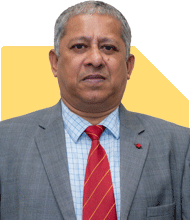I am 42 and want to retire at 50 with Rs 1 lakh salary - what mutual funds should I invest in?
Ramalingam Kalirajan |8319 Answers |Ask -Follow
Mutual Funds, Financial Planning Expert - Answered on Jul 27, 2024
He has an MBA in finance from the University of Madras and is a certified financial planner.
He is the director and chief financial planner at Holistic Investment, a Chennai-based firm that offers financial planning and wealth management advice.... more

Hi Sir, I am 42 Years Old working in Private firm.. I would like to retire at the age of 50 yrs.. I earn 1 lakh per month and can invest 50k after expenses..I have a Property of 50L worth for living..Have 20 L in PF and 4 L each in PPF and NPS and would like to continue the investments in EPF/PPF/NPS until my retirement.. Iam new to Mutual fund world and planning to start investing 50k with YOY step up for the next 8 years and later go with SWP for fixed monthly Income.. Can you please help to know the best mutual fund categories to start investing and also suggest the best fund names for each category (Growth + Direct Plan) with the investment horizon of 8 yrs... It would be more helpful if you could suggest based on the risk I can take, factoring in my age and years left for retirement.. Thanks in advance..
Current Financial Position
Monthly Salary: Rs 1 lakh
Monthly Savings: Rs 50,000
Property: Rs 50 lakh
PF: Rs 20 lakh
PPF: Rs 4 lakh
NPS: Rs 4 lakh
Investment Strategy
Goals and Risk Assessment
Given your goal to retire at 50, your investment horizon is 8 years. This is a moderate timeframe, allowing for growth with a reasonable risk profile. Considering your age and horizon, a balanced mix of equity and debt funds would be prudent.
Equity Funds
Large-Cap Funds
Large-cap funds invest in big companies. These are relatively stable. They offer moderate returns with lower risk.
Mid-Cap Funds
Mid-cap funds invest in mid-sized companies. They have higher growth potential than large-caps but come with higher risk.
Hybrid Funds
Hybrid funds mix equity and debt. They balance risk and reward well. They are ideal for moderate risk profiles.
Debt Funds
Short-Term Debt Funds
Short-term debt funds invest in fixed-income instruments. They offer stability and liquidity, which is beneficial as you near retirement.
Dynamic Bond Funds
Dynamic bond funds adjust based on interest rate movements. They provide better returns than traditional fixed-income funds.
Investment Plan
Monthly Investment Allocation
Large-Cap Funds: Rs 20,000
Mid-Cap Funds: Rs 15,000
Hybrid Funds: Rs 10,000
Short-Term Debt Funds: Rs 5,000
Yearly Step-Up
Increase your investments by a fixed percentage yearly. This will align with your salary increments and inflation.
Benefits of Actively Managed Funds
Actively managed funds have professional managers. They aim to outperform the market. They adjust the portfolio based on market conditions. This can lead to better returns than passive funds.
Disadvantages of Direct Funds
Direct funds may seem cost-effective. However, they lack professional guidance. Regular funds through a Certified Financial Planner offer expertise. They help in selecting the right funds and strategies.
Final Insights
Diversify your investments across large-cap, mid-cap, hybrid, and debt funds.
Opt for actively managed funds to potentially outperform the market.
Use a Certified Financial Planner for regular funds to get professional advice.
Increase your investment amount yearly to counter inflation.
Best Regards,
K. Ramalingam, MBA, CFP,
Chief Financial Planner,
www.holisticinvestment.in
You may like to see similar questions and answers below
Ramalingam Kalirajan |8319 Answers |Ask -Follow
Mutual Funds, Financial Planning Expert - Answered on Apr 11, 2024
Ramalingam Kalirajan |8319 Answers |Ask -Follow
Mutual Funds, Financial Planning Expert - Answered on May 21, 2024
Ramalingam Kalirajan |8319 Answers |Ask -Follow
Mutual Funds, Financial Planning Expert - Answered on Jun 28, 2024
Ramalingam Kalirajan |8319 Answers |Ask -Follow
Mutual Funds, Financial Planning Expert - Answered on Aug 12, 2024
Prof Suvasish Mukhopadhyay |612 Answers |Ask -Follow
Career Counsellor - Answered on May 05, 2025
Prof Suvasish Mukhopadhyay |612 Answers |Ask -Follow
Career Counsellor - Answered on May 05, 2025
Mihir Tanna |1052 Answers |Ask -Follow
Tax Expert - Answered on May 05, 2025
Samraat Jadhav |2269 Answers |Ask -Follow
Stock Market Expert - Answered on May 05, 2025
Samraat Jadhav |2269 Answers |Ask -Follow
Stock Market Expert - Answered on May 05, 2025
Samraat Jadhav |2269 Answers |Ask -Follow
Stock Market Expert - Answered on May 05, 2025
Ramalingam Kalirajan |8319 Answers |Ask -Follow
Mutual Funds, Financial Planning Expert - Answered on May 05, 2025
Prof Suvasish Mukhopadhyay |612 Answers |Ask -Follow
Career Counsellor - Answered on May 05, 2025
Prof Suvasish Mukhopadhyay |612 Answers |Ask -Follow
Career Counsellor - Answered on May 05, 2025
Radheshyam Zanwar |1595 Answers |Ask -Follow
MHT-CET, IIT-JEE, NEET-UG Expert - Answered on May 05, 2025























